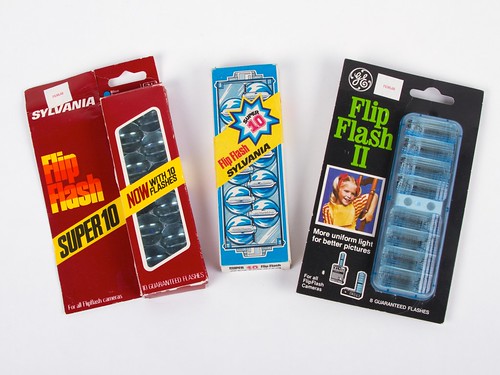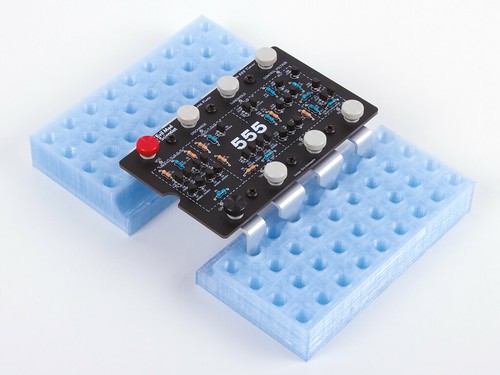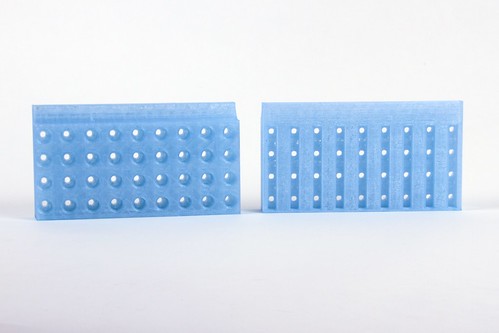During our Fourth of July sale, running through July 6, use coupon code SUMMER in your shopping cart to save 10% on some of our favorite red, white, and blue kits, and other fantastic supplies for great summer projects!
Tinkering Video Course
Our friends at the Exploratorium Tinkering Studio are currently teaching a free online course, Tinkering Fundamentals: A Constructionist Approach to STEM Learning. The six-week course has already started, but you can still join.
Electro-Kistka: Alternate In-Place Egg Dyeing Technique

After seeing our recent post on dyeing in eggs in place with the Eggbot, Ragnar posted instructions in the forums for an alternative egg dyeing technique.

It involves pre-installing a plastic dyeing bag at the time of positioning the egg in the Eggbot. Full instructions (with more photos) are in the forum post. Thank you for demonstrating this technique, Ragnar!
Women in the Maker Movement

In honor of National Women in Engineering Day, the Make blog is profiling women in the maker community this week, including me!
…this week we’d like to bring you profiles on women who are roboticists, artists, designers, programmers, and makers of all kinds over the next few days, and we’ll be making an effort to make sure that the women in the maker movement get their fair share of the spotlight as we build our maker community in the future.
Electro-Kistka: Dyeing an Egg in Place?

In our annoucement article about the EggBot Electro-Kistka — the hot wax dispenser for the EggBot — we noted that it can be challenging to reposition an egg after taking it out to dye the egg between wax layers.
As an alternative suggestion, reader Dan commented:
Could you leave the egg in the EggBot and paint on the first layer(s) of dye with a brush? Then dip the egg for the last layer to get the ends covered.
Well, let’s try and see how it turns out!
Another ASCII Tie Fighter

We just stumbled across a post from last year by WidgetNinja about using our post about CNC halftones to make Tie Fighter ASCII art using his CNC router. He used two-tone plastic mounted on plywood and carved it with a 60 degree v-carving bit. It looks great!
Open Discussion: Best Practice for Mislabeled Open Source Projects?

In looking around for examples of great open source hardware projects, we came across an unexpected number of projects and products labeled as open source hardware that, upon closer inspection, actually turn out not to meet the definition. Often, they’re using an inappropriate license— typically a “non-commercial license,” which is not only unenforceable but explicitly incompatible with open source values. Sometimes, they haven’t released the design files. Sometimes, a person has apparently misused the term “open source” to mean “closed and proprietary.” And sometimes you might see the open hardware logo used without any substance to back it up.
But what (if anything) can or should be done about it? We’d like to solicit your input as to the best ways to approach this problem. Perhaps there are not any easy answers.
As a baseline, we think that it’s important to address the problem, and to do so earlier rather than later. To mislabel a product for sale as open source hardware may constitute false advertising, illegal in the US under state and federal law. In noncommercial projects where nothing is for sale, misusing the terms may help to set precedent that can damage the community’s understanding of open source. For instance, if enough people see non-commercial licenses on things labeled as be open source, they may assume that it is acceptable.
If you happen to know someone behind the project, you might consider contacting them directly to start a dialog about what it means for something to be “open source.” Or, you could (hint hint hint) send them a link to this article, letting them know that you found it interesting!
But, what if you don’t have any personal connections to the people involved? It’s certainly not as easy. Sometimes you can initiate a dialog with a company, perhaps by asking about their design files or licenses. At the other end of the spectrum, people sometimes bring up options like public shaming. In our view, shaming is harmful to the open source community, and should be considered a last resort akin to violence. Rather, we as a community need to work towards positive ways to nudge people toward doing the right thing.
Please let us know what you think: what should you do when you come across a project mislabeled as open source hardware?
Ingenious 1970’s Technology: The Flip Flash
Once upon a time, cameras did not come with LED illumination or even xenon strobes, but rather with a socket that could fire a one-time-use flashbulb.
An advance from this was the “flip flash” cartridge which held 8 or 10 flash bulbs, ganged up so that you could take one photo after another, without pausing to swap bulbs. Each time that you took a picture (exposing actual film!), the next flashbulb in the cartridge would fire.
But you might ask a tricky question here: How does it know which bulb to fire next?
Continue reading Ingenious 1970’s Technology: The Flip Flash
A Giant Breadboard for the Giant 555
One of the common reactions that people have when they first see our Three Fives kit is to joke “Now all I need is a giant breadboard!” Well, Michael Pechner actually designed and made one, and put the files up on Thingiverse. He built the design in Fusion 360 with a little help from Michael Gregg and printed it out in PLA ABS on his 3D printer.
Thus far, the design is “plastic only,” without the metal inserts that one would find in a real electronic breadboard — but that’s okay, since the aluminum legs on the Three Fives kit are also decorative rather than functional. But, there are holes in the tops and slots in the bottom in case someone would like to add them.
3D LED POV Mirror
“We Are with You, Mirror” is a piece by Brady Marks from VIVO Media Arts Centre that was shown at the Vancouver Mini Maker Faire. It is a 3D persistence of vision volumetric display that acts as a mirror, using four spinning Peggy 2 boards to reflect visitors movements in low resolution 3D LED glory.
Thank you to Brady for sending in the video!








